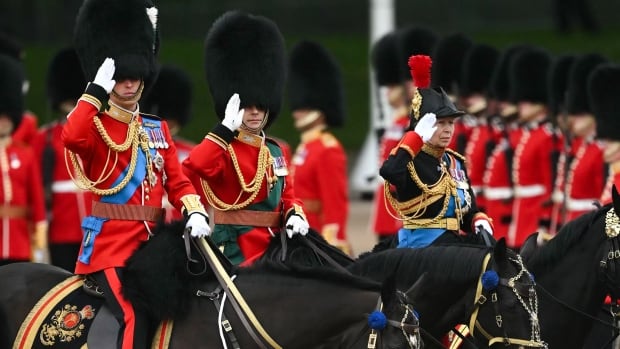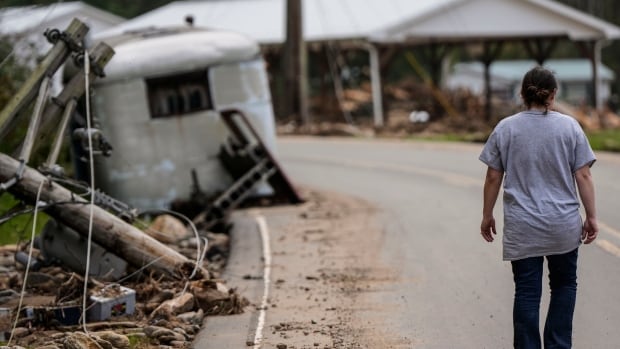Hello, royal watchers. This is your regular dose of royal news and analysis. Reading this online? Sign up here to get this delivered to your inbox.
She’s often been called the “hardest-working royal,” long regarded for her deep devotion to royal duties.
And there is every expectation that Princess Anne will reschedule the visit the no-fuss, down-to-earth royal was meant to make to Newfoundland this weekend once the 73-year-old has recovered from the head injury she sustained at her estate in western England a few days ago. (Anne was released from hospital and returned to her home on Friday.)
Still, the absence of King Charles’s sister in Canada — and from a jam-packed itinerary in the U.K. over the past week — reinforces a larger issue for the Royal Family these days.
“It certainly is a reminder of how few working royals there are,” Justin Vovk, a royal commentator and a PhD candidate at McMaster University in Hamilton who specializes in the history of the monarchy, said in an interview.
“And I think more than that, it’s a reminder of how much she does — the fact that these visits had to be cancelled, these obligations had to be cancelled, the fact that they couldn’t simply slot somebody else in.”
For several years, there has been a general sense that once King Charles became monarch, there would be a move toward a “slimmed-down” monarchy.
Princess Anne has had to postpone numerous upcoming events, including a trip to Newfoundland, after suffering a concussion and other injuries from reportedly being struck by a horse’s head or legs.
What that means, exactly, has been somewhat elusive, but the general sense has been an expectation that fewer senior Royals would carry out official duties — an idea telegraphed, for example, by fewer of them appearing on the balcony of Buckingham Palace for formal occasions.
Anne herself didn’t seem convinced about the idea in an interview with the CBC’s chief correspondent, Adrienne Arsenault, last year.
“Well, I think the ‘slimmed-down’ was said in a day when there were a few more people around,” Anne said.
“It doesn’t sound like a good idea from where I’m standing, I would say. I’m not quite sure what else we can do.”
Princess Anne invites CBC Chief Correspondent Adrienne Arsenault into her sitting room and opens up about her brother’s coronation, the monarchy’s future, and her lifetime of service.
There’s no doubt Anne’s temporary absence from the working ranks will be felt, coming as it does particularly after both King Charles and his daughter-in-law, Catherine, Princess of Wales, were diagnosed with undisclosed forms of cancer a few months ago.
“This is clearly the last thing that the monarchy really needs after the year they’ve had,” Robert Hardman, author of Charles III: The Inside Story, told CBC News from London.
“[Anne] has been absolutely sort of central to stepping in as things have got tough.”
Particular focus on the idea of a slimmed-down monarchy emerged around the time of Queen Elizabeth’s Diamond Jubilee, marking 60 years as monarch, in 2012.
“It was at that point that the Queen very visibly and very actively started to involve the then-Prince of Wales in various decisions,” said Judith Rowbotham, a social and cultural scholar and visiting research professor at the University of Plymouth in southwestern England, in an interview.

From time to time, the slimmed-down idea would crop up again.
“It became that bit more prominent once again over the Prince Andrew issue, over the problems, the expense, the debts and so on … that Sarah, Duchess of York had got into,” said Rowbotham.
“They were seen as representative of a drain on the public finances and letting the side down, the Royal Family side down.”
Charles has, Rowbotham said, “always had the vision that it was going to be the direct line [of succession] and he is trying to send a message.”
Other members of family may appear on the Buckingham Palace balcony or at other royal events from time to time, but Rowbotham doesn’t suggest seeing that as an expansion of who might be considered a working royal.

“They’ll be around, but they won’t be considered working royals. There’ll be no argument that they are costing the taxpayer, the public purse directly.”
Beyond the family itself, Rowbotham sees another potential way a slimmed-down monarchy might manifest itself — what might happen with royal estates and properties.
“Sandringham is already being converted into and had been since before the late Queen’s death, into a working estate, a profitable estate, models of organic farming, various other things like that.”
Still, the question of exactly what a slimmed-down monarchy means isn’t precisely clear.
“I don’t know if anybody has a conclusive definition of what it means for the monarchy at this time,” Vovk said, “because I don’t think at any point did anyone consider that the senior-most members would be incapacitated for periods of time with these medical issues.”

Vovk said he would be shocked if Anne’s situation right now isn’t creating “a series of conversations at Buckingham Palace about who do we constitute as working.”
“I mean, thank God, Princess Anne — her injury doesn’t seem to have been too-too serious — but if she were incapacitated for longer, we are getting down to working members of the Royal Family [that can be counted] on less than one hand.”
Vovk sees the idea of a slimmed-down monarchy working out differently among the various European countries where it has emerged.
“Spain is arguably more comparable to Britain in terms of its population, role of the monarchy, etc. They seem to be making it work with just the king, queen and one or two other people,” he said.

“That has never really worked in Britain, though. Britain has always been able to rely on a large extended family and I don’t know if the British Crown knows what to do next in that sense.
“They’re so used to relying on precedent and how we’ve done it in the past without these sort of major, unexpected trials coming up, like being incapacitated by illness.”
Vovk says he’s still waiting to hear what a slimmed-down monarchy will actually mean.
“I was honestly expecting months ago we were going to have a kind of a formalized list of who will be activated as working members. So I suspect that the ‘slimmed-down monarchy’ is now an umbrella term for deploying people on a situation-by-situation basis.”
A social media milestone
On the surface, it was simply a happy social media post signed “G, C & L,” marking the first time Prince George, Princess Charlotte and Prince Louis shared a message on social media.
The post featuring a picture of the children with their dad, Prince William — backs to the camera, all casually dressed at the beach — appeared on Father’s Day.
We love you, Papa. Happy Father’s Day 💕 G, C & L<br><br>📸 The Princess of Wales, 2024 <a href=”https://t.co/kI9AFV2XmT”>pic.twitter.com/kI9AFV2XmT</a>
—@KensingtonRoyal
Beyond the family photo and kind words about their father, however, the post seemed to be aiming for a broader message.
“I thought that that was a very clever … part of this slow introduction of the next generation into the public consciousness, that this is the future of the Royal Family and very much part of the image that the Royal Family are not remote, aloof alien beings, but are very much human, with various ups, downs, troubles,” said Rowbotham.
Vovk also saw the post as humanizing, and “very personal,” particularly because of its use of the word “love.”
“That is not something until this generation we have seen in a public forum — members of the Royal Family — at least not in the immediate line of succession — saying ‘I love you, we love you.'”
Still, there was some royal tradition there, Vovk said, with the children calling their father “Papa,” as have many previous generations of royal children.
That the post would be part of efforts to foster a particular image of the family is not surprising.
“We live in an image-based society in which anybody with a public profile has to be conscious of the image they are presenting”, Vovk said.
“The visual element, the photographic element is now such an important part of how the monarchy interacts with its subjects and interacts with people. We saw that with the Mother’s Day post,” he said, referencing the controversy that swirled around an edited image of Catherine and the children posted three months ago.

The Father’s Day image courted no such controversy.
“It has shown that a properly deployed image can really be an effective tool in connecting with people and communicating what they value,” said Vovk.
The social media posts with the kids continued throughout the past few days, with another beach shot of William and the children to mark his 42nd birthday, this one with all faces forward as they took a giant leap over waving grass.
Happy birthday Papa, we all love you so much! Cx <a href=”https://t.co/NROqRbt4rs”>pic.twitter.com/NROqRbt4rs</a>
—@KensingtonRoyal
“It was fun and I think that’s something that people want to see from this generation of Royals,” said Vovk. “They want to see that they are still people who are able to have fun. They are able to humanize and relate with them.”
And then there were the selfies of William and the kids with pop superstar Taylor Swift when her Eras tour landed at London’s Wembley Stadium.
Thank you <a href=”https://twitter.com/taylorswift13?ref_src=twsrc%5Etfw”>@taylorswift13</a> for a great evening! <a href=”https://twitter.com/hashtag/LondonTSTheErastour?src=hash&ref_src=twsrc%5Etfw”>#LondonTSTheErastour</a> <a href=”https://t.co/NFSi8hAl1o”>pic.twitter.com/NFSi8hAl1o</a>
—@KensingtonRoyal
Royal encounters with celebrities are nothing new.
“Just as you used to see Prince Charles with various celebrities in his dashing days, it’s not surprising that [William] turned up at the concert,” said Rowbotham.
The most recent shots offered a more casual view of George and Charlotte than has generally been seen.
“First off, it was nice to see Prince George smiling like that,” said Vovk. “He has so much pressure on him and you can see in the formal ceremonials … remains very, very formal.”
As much as William and George were having a good time, though, Vovk thought it was “Charlotte’s moment.”
“That look on her face, that smile, that was pure, pure fandom. And the fact that you have members of the Royal Family … the Royals take their kids to concerts like anybody else. These are children that people around the world look to and they still have their music idols, they still have their favourite celebrities.”
The backstage moments included time with Swift’s boyfriend, Travis Kelce, and his brother, Jason Kelce.
Happy Bday M8! London shows are off to a splendid start 🇬🇧🇺🇸🤝 <a href=”https://twitter.com/KensingtonRoyal?ref_src=twsrc%5Etfw”>@KensingtonRoyal</a> <a href=”https://t.co/VlD6V0PiEL”>pic.twitter.com/VlD6V0PiEL</a>
—@taylorswift13
On their podcast a few days later, the football players seemed chuffed by the whole experience.
“They were wonderful people, and that’s what it’s about,” Jason said, according to a report in the Daily Mail. “They’re part of a monarchy, [it’s] hard to be a down-to-earth human being — I would assume. But [they] came off that way completely.”
An ‘appalling ignorance’

Our CBC News friend Natalie Stechyson had this report following the recent appearance by Catherine, Princess of Wales, at Trooping the Colour.
When Catherine, Princess of Wales, smiled at the crowds at Trooping the Colour, her first public appearance since December, the general reaction online could perhaps best be characterized with two statements:
No. 1: She looks great. No. 2: Why?
It had been nearly three months since Catherine revealed she was undergoing preventative chemotherapy for an undisclosed type of cancer discovered after an abdominal surgery in January. Since Christmas, the public hadn’t seen Catherine — other than two photos and one pre-recorded video released by Kensington Palace on social media.
One of those photos was actually an announcement and health update confirming that Catherine, 42, would be attending King Charles’s official birthday celebration in London, also known as Trooping the Colour.
Then Catherine appeared on June 15 as promised, waving, smiling and described on both social media and traditional media as “radiant,” “gorgeous” and “elegant.” Her return to the public eye has been called triumphant, and “the dazzling cherry on the birthday cake.”
And yet, many others wondered if she shouldn’t look … worse. People questioned why the princess still had her hair, for instance. Others wondered if it was really her, after all, or saw the princess’s seemingly healthy appearance as “proof” for a range of rampant conspiracy theories.
These reactions, as well as a widely lambasted column in The Telegraph that praised Catherine for “channelling the gamine beauty of Audrey Hepburn” when “lesser mortals would have stayed at home” in their pyjamas, have been criticized by the cancer community as uneducated and harmful.
“Who in their right mind thought this comment was acceptable? To anyone living, navigating and struggling with the massive physical, mental and financial impact of a cancer diagnosis and treatment, you are not #LesserMortals and please never believe that you are!” Sophie Blake, a U.K. woman living with secondary breast cancer, wrote on X.
“There is no right or wrong way to navigate cancer. People do the best they can with what they have available, at the stage they’re at. There are no #lessermortals. We’re all just human beings, trying to stay alive! Such careless and offensive language shows appalling ignorance,” wrote X user Helen Aitken.
There is no right or wrong way to navigate cancer. People do the best they can with what they have available, at the stage they’re at. There are no <a href=”https://twitter.com/hashtag/lessermortals?src=hash&ref_src=twsrc%5Etfw”>#lessermortals</a>. We’re all just human beings, trying to stay alive!<br>Such careless and offensive language shows appalling ignorance.
—@hjd_aitken
It’s a myth that you have to look “sick” when you have cancer or are undergoing chemotherapy, Dr. Keith Stewart, the director of the Princess Margaret Cancer Centre in Toronto, told CBC News.
“Many people with cancer and on treatment are walking around leading pretty visibly normal and healthy lives.”
There are many effective drugs that don’t cause hair loss, nausea or vomiting, Stewart said. That said, there are still other “difficult” but less visible side-effects, like fatigue, neuropathy and changes in appetite, he added.
Statements claiming that Catherine perhaps doesn’t look sick enough, or conversely, comparisons of how good she looks compared to “lesser mortals,” are ultimately harmful and hurtful, Stewart said.
“Just because you don’t look terrible with your hair falling out in clumps doesn’t mean you’re not suffering, that you’re not experiencing the trauma and anxiety of developing a cancer at such a young age,” he said.
“It’s actually wrong to assume everybody is going to be like that.”
Catherine, Princess of Wales, attended the Trooping the Colour parade in London on Saturday, delighting members of the public who turned out for her first official appearance since her cancer diagnosis earlier this year. Other members of the Royal Family took part in the ceremony, including King Charles, who is also being treated for cancer.
While hair loss is a common side-effect of chemotherapy, not all chemotherapy drugs cause it, the Canadian Cancer Society says on its website. Even then, hair loss can vary from person to person, the society adds.
How much hair a person may lose depends on the type, dose and combination of the drugs, how the drug is given and the length of treatment, the Canadian Cancer Society says.
People can also experience a range of other symptoms during cancer treatments, including fatigue, nausea and vomiting, loss of appetite, diarrhea, inflammation, vision changes, mouth sores and pain. Cancer itself is experienced differently depending on the type, severity and person, the Canadian Cancer Society notes.
Royally quotable
“As a 21-year-old, the innovations I saw left me with a lasting impression of the power of blending the traditions of Eastern and Western civilizations, together with progress in science and technology for the benefit of all.”
— King Charles speaks of his first trip to Japan in 1970, in a speech at the banquet during the state visit by Emperor Naruhito and Empress Masako.

Royal reads
-
King Charles’s principal private secretary sat next to Labour Party Leader Keir Starmer at a state banquet in Buckingham Palace, little more than a week before the U.K. general election. Prime Minister Rishi Sunak, meanwhile, was seated next to a celebrated computer scientist from his home town of Southampton. Given that the King will, at the end of next week, be asking one of the party leaders to form the next government, it was an interesting choice of seating plan. [ITV]
-
Prince Harry had an emotional conversation about bereavement and grieving with a charity founder who helps military families facing the loss of a loved one. [BBC]
-
A viral video of Prince William dancing at the Taylor Swift concert has prompted experts to laud benefits of men “communicating their hormones,” from lifting mood to boosting trust. [The Guardian]
-
A collection of items once owned by members of the Royal Family, including dresses and notes by the late Diana, Princess of Wales, has sold for more than four million pounds at auction in California. [BBC]
Sign up here to have The Royal Fascinator newsletter land in your inbox every other Friday.
I’m always happy to hear from you. Send your questions, ideas, comments, feedback and notes to royalfascinator@cbc.ca. Problems with the newsletter? Please let me know about any typos, errors or glitches.








